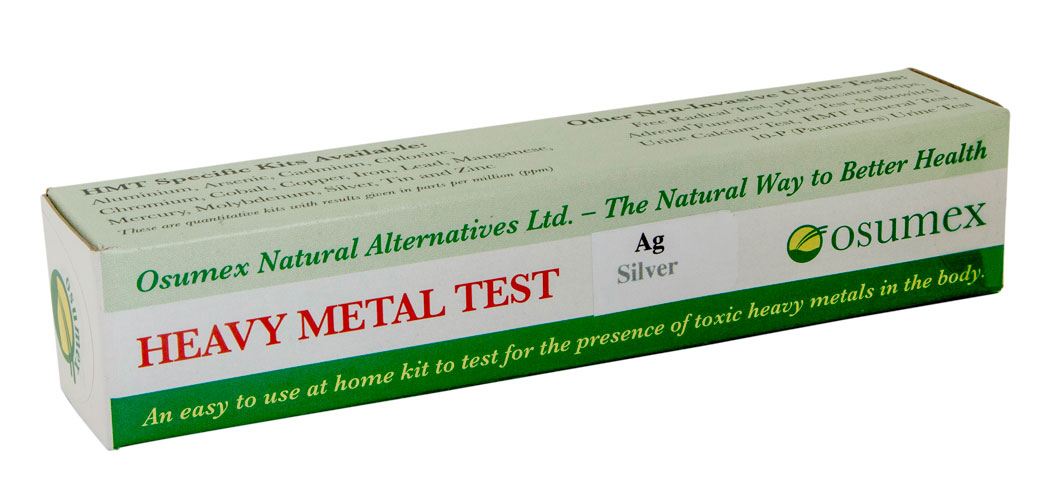|
| Adrenal Function Urine Test |
| Sulkowitch Urine (Calcium) Test |
|
|
|
SILVER
Number 47 on the "periodic table" of elements
Tests the presence of ions of silver to a high degree of accuracy to
detect contamination in the body and on a wide range of materials in your environment
Silver has been known since ancient times. Silver occurs native and in ores such as argentite (Ag2S)
and horn silver (AgCl); lead, lead-zinc, copper, gold, and copper-nickel ores are principal sources. Silver is
also recovered during electrolytic refining of copper.
Pure silver has a brilliant white metallic luster. It is a little harder than gold and is very ductile and
malleable, being exceeded only by gold and perhaps palladium. It is stable in pure air and water, but tarnishes
when exposed to ozone, hydrogen sulfide, or air containing sulfur. Silver is of the utmost importance in photography,
about 30% of the U.S. industrial consumption going into this application.
While silver itself is not considered to be toxic, most of its salts are poisonous. Silver compounds can be absorbed
in the circulatory system and reduced silver deposited in the various tissues of the body. A condition, known as argyria,
results with a greyish pigmentation of the skin and mucous membranes.
Silver plays no natural biological role in humans.
Silver Sources
The principal sources of silver are copper, copper-nickel, gold, lead and lead-zinc ores obtained from Canada, Mexico, Peru, and the United
States.
Silver Toxicity and Symptoms
Soluble silver salts, specially AgNO3, are lethal in concentrations of up to 2g (0.070 oz). Silvercompounds can be slowly absorbed by body
tissues, with the consequent bluish or blackish skin pigmentation (argiria).
Eye contact - may cause severe corneal injury if liquid comes in contact with the eyes. Skin contact: may cause skin irritation. Repeated and
prolonged contact with skin may cause allergic dermatitis. Inhalation hazards: exposure to high concentrations of vapors may cause dizziness,
breathing difficulty, headaches or respiratory irritation. Extremely high concentrations may cause drowsiness, staggering, confusion,
unconsciousness, coma or death.
Liquid or vapor may be irritating to skin, eyes, throat, or lungs. Intentional misuse by deliberately concentrating and inhaling the
contents of this product can be harmful or fatal.
Ingestion hazards - moderately toxic. May cause stomach discomfort, nausea, vomiting, diarrhea, and narcosis. Aspiration of material into
lungs if swallowed or if vomiting occurs can cause chemical pneumonitis which can be fatal.
Chronic overexposure to a component or components in this material has been found to cause the following effects in laboratory animals:
- Kidney damage
- Eye damage
- Lung damage
- Liver damage
- Anemia
- Brain damage
Chronic overexposure to a component or components in silver has been suggested as a cause of the following effects in humans:
- Cardiac abnormalities
- Reports have associated repeated and prolonged overexposure to solvents with permanent brain and nervous system damage.
- Repeated breathing or skin contact of methyl ethyl ketone may increase the potency of neurotoxins such as hexane if exposures occur at the same time.
Silver Toxicity Limits
The permissible exposure limit by OSHA and most other authorities is 0.1 mg/m3. Organic silver in colloidal form has been used as a detox
agent. However, concentrations should be 0 for both organic and inorganic silver.
Check out silver levels in your body with our easy to use, home-based,
HMT Silver Test kit
 
Sample of a HMT Silver Test kit

The above information is provided for general
educational purposes only. It is not intended to replace competent
health care advice received from a knowledgeable healthcare professional.
You are urged to seek healthcare advice for the treatment of any
illness or disease.
Health Canada and the FDA (USA) have not evaluated these
statements. This product is not intended to diagnose, treat, cure, or prevent
any disease.
|


